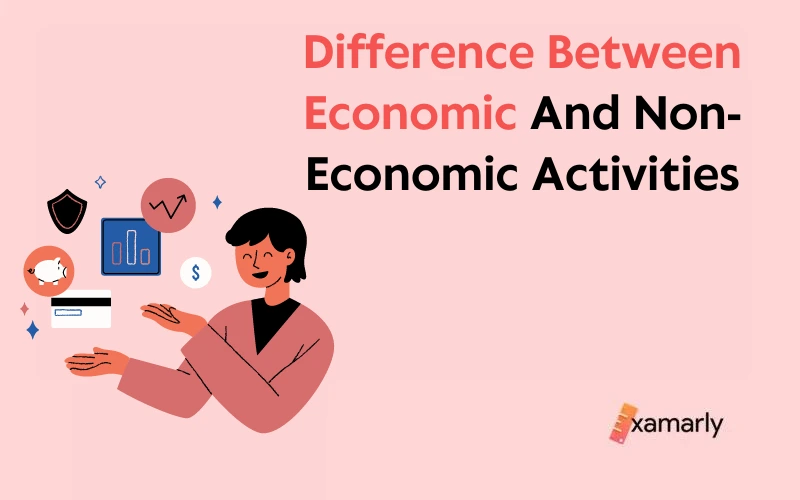Think about the last time you bought something. Chances are, you didn’t just stumble upon it, it was produced, marketed, and sold to you. That’s what makes the economy runs, the exchange of goods and services. But have you ever stopped to wonder what lies behind the curtain, what drives these exchanges? Is it just about making a profit or something more?
Dive into the world of economic and non-economic activities, where money and personal benefit collide to shape the economy we know.
This article revolves around the difference between Economic And Non Economic Activities which provides you a useful insight into this and hence is beneficial for the UPSC Examination.
What Are Economic Activities?
Economic activities refer to any actions or transactions that involve the production, distribution, and consumption of goods and services. These activities are vital to the functioning of an economy and include a wide range of activities such as agriculture, manufacturing, construction, retail, and service industries.
Economic activities can be divided into primary, secondary, and tertiary sectors. The primary sector includes activities such as agriculture, mining, and fishing. The secondary sector includes activities such as manufacturing and construction. The tertiary sector includes activities such as retail, healthcare, and education.
Economic activities also involve the exchange of goods and services, usually in the form of money, which is facilitated by financial institutions such as banks. Economic activities also generate income and employment opportunities, which in turn drive economic growth.
Economic activities are also influenced by various economic factors such as supply and demand, interest rates, and government policies.
For example, an increase in demand for a particular product can lead to an increase in production and employment opportunities, while an increase in interest rates can lead to a decrease in borrowing and spending. Government policies such as taxes and regulations can also impact economic activities.
What Are Non-Economic Activities?
Non-economic activities refer to actions or transactions that do not involve the production, distribution, and consumption of goods and services. These activities are not directly related to the economy, but they can still have an impact on it. Examples of non-economic activities include activities such as volunteering, parenting, and leisure activities.
Non-economic activities can be classified into social, cultural, and personal activities. Social activities refer to actions that involve interacting with others, such as volunteering or participating in community events.
Cultural activities refer to actions that involve the arts, such as visiting a museum or listening to music. Personal activities refer to actions that involve self-care or personal development, such as exercising or reading.
Non-economic activities have a significant impact on the economy, as they can lead to the development of new ideas, creativity, and innovation. Moreover, non-economic activities can also lead to the development of human capital, which is essential for economic growth.
Additionally, non-economic activities can also lead to the development of social capital, which refers to the trust, norms, and networks that facilitate cooperation and coordination among individuals. Social capital is essential for the functioning of a society and can lead to the development of a more resilient and sustainable economy.
Difference Between Economic Activities And Non-Economic Activities
| Economic activities | Non-economic activities |
| Economic activities refer to the production, distribution, and consumption of goods and services in an economy. | Non-economic activities, on the other hand, do not involve the exchange of money and are not intended to generate a profit. |
| These activities involve the exchange of money and are intended to generate a profit. To put it another way, the provision of services and the acquisition of monetary remuneration are the two primary goals of economic activities. | These activities are typically performed for personal or societal benefit rather than for financial gain. |
| Examples include manufacturing, agriculture, and retail trade. 1. Baker baking cookies to earn profit | Examples include volunteer work, raising children, and taking care of elderly family members. 1. Baker is baking cookies for his/her family to earn satisfaction and happiness. |
| Economic activity is what drives the nation’s economic development and growth. | During non-economic activities, psychological and social development can be observed. |
| Primary, secondary, and tertiary sectors are the three categories that make up economic activity. | Non-economic activities are not segmented; rather, they are mostly based on preferences, habits, interests, hobbies, etc. |
| A monetary scale is used to assess economic activity. | Activities that are not economic cannot be measured. |
| There is a pragmatic approach to economic activities. | Activities that are non-economic have an idealistic approach. |
| Economic activity promotes the creation of wealth and assets. | Activities that aren’t related to economics make people happy and satisfied. |
| Economic activities involve the use of resources, such as labor, capital, and raw materials, to produce goods and services. | Non-economic activities also involve the use of resources, such as time and energy, to perform tasks that are not directly related to the production and distribution of goods and services. |
| The most common sorts of economic activity are business, employment, etc. | The most common forms of non-activities are things like self-satisfaction and social duty. |
Similarities
- Both economic and non-economic activities involve the use of resources.
- Both types of activities have a specific purpose and goal in mind.
- Both economic and non-economic activities can have a positive or negative impact on society: Economic activities can have a positive impact on society by generating jobs and income, while non-economic activities can have a positive impact on society by promoting social cohesion and well-being. However, both economic and non-economic activities can also have a negative impact on society if not managed properly.
- Both economic and non-economic activities are important for the overall functioning of an economy: Economic activities are considered the backbone of any economy, as they drive the production and distribution of goods and services. Non-economic activities, although not directly related to the production and distribution of goods and services, play a crucial role in shaping the well-being of individuals, families, and communities.
- Both economic and non-economic activities are subject to ethical considerations: Economic activities are subject to ethical considerations such as fair labor practices and environmental sustainability. Non-economic activities are also subject to ethical considerations such as respect for personal autonomy and the rights of marginalized communities.
- Both economic and non-economic activities can be affected by demographic changes: Economic activities can be affected by demographic changes such as changes in the age structure and migration patterns of a population. Non-economic activities can also be affected by demographic changes such as changes in family structure and the number of people in a community.
- Both economic and non-economic activities can benefit from technology: Economic activities can benefit from technology through increased efficiency and productivity. Non-economic activities can also benefit from technology through increased access to information and communication.
Examples Of Economic Activities
These are the activities that involve the production, distribution, and consumption of goods and services. Examples include:
- Farming: growing crops or raising livestock for sale
- Manufacturing: producing goods in a factory
- Retail: selling goods to consumers
- Finance: providing loans or managing investments
- Transportation: moving people or goods from one place to another
The return of such activities is expressed in monetary terms.
Examples Of Non-economic Activities
Non-economic activities are activities that do not involve the production, distribution, or consumption of goods and services. Examples include:
- Volunteering: helping out at a community organization without being paid
- Child-rearing: taking care of children without receiving money for it
- Hobbies: engaging in activities such as painting or playing sports without earning money from it
- Household work: cleaning, cooking, and other daily tasks done in the house without generating an income
- Socializing: spending time with friends or family without any financial gain.
How To Identify Whether Any Human Activity Is Economic Or Non-Economic?
On every given day, every single human being engages in a diverse range of activities. We engage in both daily work and activities for our own delight and fulfillment. Therefore, we may conclude that all of the things we perform to make a living are, in general, considered economic activities. Non-economic activities include all other activities.
Economic activities can be recognized by the fact that they are motivated by logic and reason. We engage in these activities because it is in our own best interests.
We’ll evaluate the benefits we receive in return for engaging in such activities.
On the other hand, non-economic actions are those that are performed out of an emotional need or out of care for another individual.
Therefore, all forms of religion, charity, social interaction, patriotism, and leisure are non-economic pursuits.
On the other hand, determining the nature of an activity is not always straightforward. Painting is a non-economic activity if you like to do it for pleasure. But if you decide to sell your paintings, then it turns into a form of economic activity.
Therefore, the reason for engaging in any activity is a good indication of its nature.
Conclusion
In conclusion, economic and non-economic activities are two distinct types of activities that shape the functioning of an economy. While they may seem different at first glance, they are connected and interdependent in many ways. Understanding the similarities between economic and non-economic activities is crucial for understanding the overall functioning of an economy and for making informed decisions about economic and social policies.
FAQs
What is the main difference between economic and non-economic activities?
The main difference between economic and non-economic activities is that the former is driven by the pursuit of profit while the latter is driven by personal or societal benefit.
Does shopping come under economic or non-economic?
Shopping can be considered both economic and non-economic depending on the context and the purpose of the purchase. When shopping is done for personal consumption, such as purchasing clothes for personal use, it is considered a non-economic activity as it is mainly for personal satisfaction and not for financial gain. However, when shopping is done for the purpose of reselling the goods or using them in production, it is considered an economic activity, as it is intended to generate a profit. In short, it is the purpose behind the purchase that determines whether shopping is considered an economic or non-economic activity.
All business activities are economic activities but all economic activities are not business activities. Why?
Business activities refer to the activities undertaken by an organization or individual to earn a profit. Economic activities, on the other hand, refer to any activity that involves the production, distribution, and consumption of goods and services. While all business activities are economic activities because they involve the production, distribution, and consumption of goods and services, not all economic activities are business activities. Economic activities such as government spending, charity work, and household activities are not undertaken with the goal of monetary gain and therefore are not considered business activities.
What are Economic and Non-Economic Activity?
Economic activities are actions and operations that involve the production, distribution, and consumption of goods and services with the goal of earning a profit. These activities have a monetary value and are subject to the laws of supply and demand. Examples of economic activities include manufacturing products, providing services, buying and selling goods, and marketing and advertising.
Non-economical activities, on the other hand, are actions and operations that do not involve the production, distribution, and consumption of goods and services and are not undertaken with the goal of earning a profit. Examples of non-economic activities include household activities, volunteer work, and hobbies. These activities do not have a monetary value and are not subject to the laws of supply and demand.






